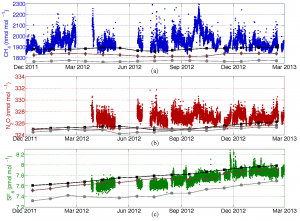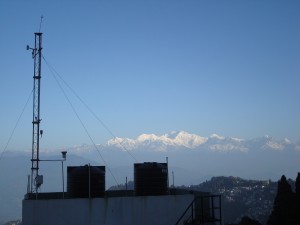One of my main research interests is in measuring the concentrations of greenhouse gases in South Asia, an area that holds significant implications for global climate and climate policies. Despite its importance, this region of the world is poorly monitored by global atmospheric monitoring networks. In 2011, collaborators from the Bose Institute, Kolkata, India and I implemented a new greenhouse gas monitoring station at a remote field site in Darjeeling, India, with the aim of making high-frequency and high-precision measurements of potent greenhouse gases.
To accomplish this goal, I built an automated, custom gas chromatograph based system equipped with a flame ionization detector (FID) for detection of CH4, and an electron capture detector (ECD) for N2O and SF6. Sampling occurs every 12 minutes and results in 60 calibrated measurements per day. How are greenhouse gases measured?
The first year of data has been published in Atmospheric Chemistry and Physics and describes the methodology and signals that were observed in this first year. We found that while SF6 mole fractions generally followed the assumed background levels for that latitude and altitude, CH4 and N2O mole fractions were greatly enhanced. This elevation is caused by the significant regional sources of these gases in South Asia. We found that, in particular, the summer monsoon season led to the most interception of regional pollution sources owing to the strong southwesterly flow that transport pollutants across the subcontinent to Darjeeling.
The instrument was deployed to Darjeeling in November 2011. For more information and pictures about the deployment and installation of the equipment, visit my blog!




